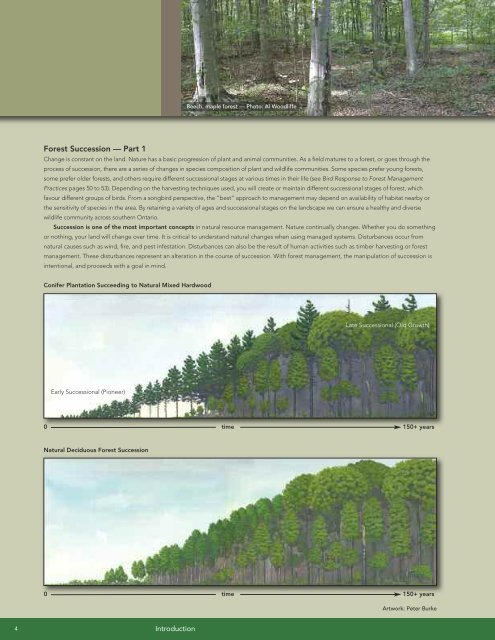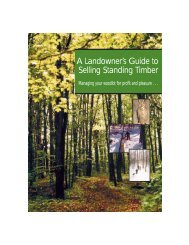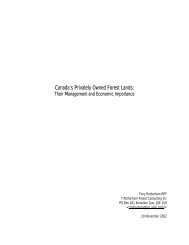A land manager's guide to conserving habitat for forest birds in ...
A land manager's guide to conserving habitat for forest birds in ...
A land manager's guide to conserving habitat for forest birds in ...
You also want an ePaper? Increase the reach of your titles
YUMPU automatically turns print PDFs into web optimized ePapers that Google loves.
Beech, maple <strong>for</strong>est — Pho<strong>to</strong>: Al Woodliffe<br />
Forest Succession — Part 1<br />
Change is constant on the <strong>land</strong>. Nature has a basic progression of plant and animal communities. As a field matures <strong>to</strong> a <strong>for</strong>est, or goes through the<br />
process of succession, there are a series of changes <strong>in</strong> species composition of plant and wildlife communities. Some species prefer young <strong>for</strong>ests,<br />
some prefer older <strong>for</strong>ests, and others require different successional stages at various times <strong>in</strong> their life (see Bird Response <strong>to</strong> Forest Management<br />
Practices pages 50 <strong>to</strong> 53). Depend<strong>in</strong>g on the harvest<strong>in</strong>g techniques used, you will create or ma<strong>in</strong>ta<strong>in</strong> different successional stages of <strong>for</strong>est, which<br />
favour different groups of <strong>birds</strong>. From a songbird perspective, the “best” approach <strong>to</strong> management may depend on availability of <strong>habitat</strong> nearby or<br />
the sensitivity of species <strong>in</strong> the area. By reta<strong>in</strong><strong>in</strong>g a variety of ages and successional stages on the <strong>land</strong>scape we can ensure a healthy and diverse<br />
wildlife community across southern Ontario.<br />
Succession is one of the most important concepts <strong>in</strong> natural resource management. Nature cont<strong>in</strong>ually changes. Whether you do someth<strong>in</strong>g<br />
or noth<strong>in</strong>g, your <strong>land</strong> will change over time. It is critical <strong>to</strong> understand natural changes when us<strong>in</strong>g managed systems. Disturbances occur from<br />
natural causes such as w<strong>in</strong>d, fire, and pest <strong>in</strong>festation. Disturbances can also be the result of human activities such as timber harvest<strong>in</strong>g or <strong>for</strong>est<br />
management. These disturbances represent an alteration <strong>in</strong> the course of succession. With <strong>for</strong>est management, the manipulation of succession is<br />
<strong>in</strong>tentional, and proceeds with a goal <strong>in</strong> m<strong>in</strong>d.<br />
Conifer Plantation Succeed<strong>in</strong>g <strong>to</strong> Natural Mixed Hardwood<br />
Late Successional (Old Growth)<br />
Early Successional (Pioneer)<br />
0 time 150+ years<br />
Natural Deciduous Forest Succession<br />
0 time 150+ years<br />
Artwork: Peter Burke<br />
4<br />
Introduction

















